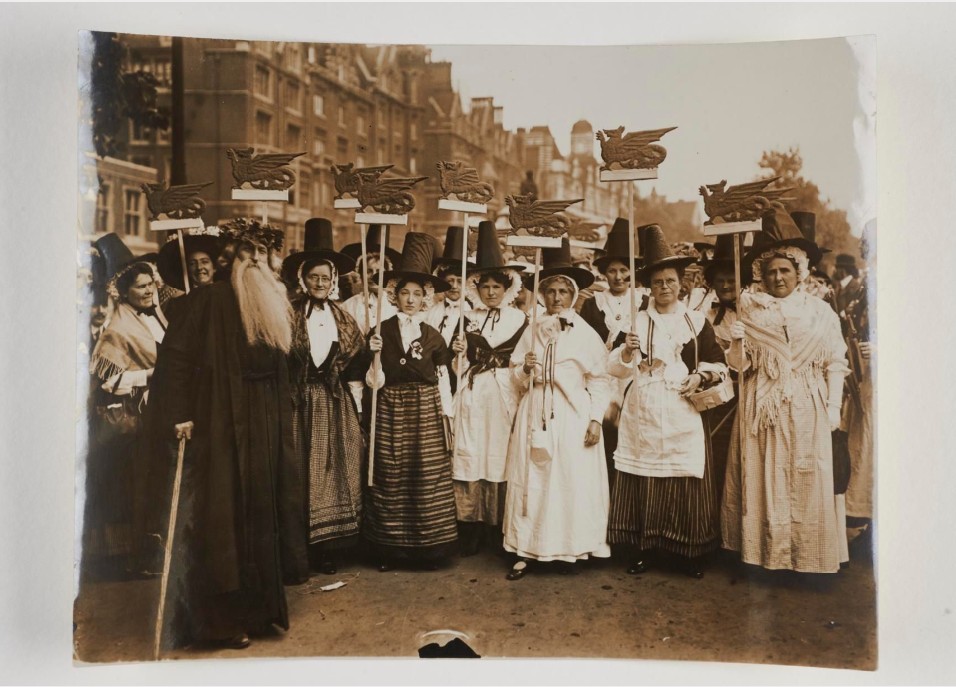Writing Wales Back In: The Role of Welsh Women in the Suffrage Movement
By Megan Davies
I’ve just completed my final year as a BA History student at Loughborough University. This September, I’ll be moving to London to begin a Law conversion course, building on the analytical, research, and communication skills I’ve developed over the past three years. My time at Loughborough has been an incredible and formative experience, and I will miss it dearly.

‘Welsh Suffragettes at the Coronation Procession’, 1911.
Photograph courtesy of the London Museum. Printed ephemera collection, Object ID: 2003.46/44. Online: Welsh Suffragettes at the Coronation Procession | London Museum
When the time came to choose a dissertation topic, I knew mine had to be rooted in my Welsh identity. With the dissertation spanning the entire final year of my degree, I wanted a project that I could both take pride in and remain genuinely invested in throughout. Exploring a subject that combined my passion for Welsh history and women’s political advancement felt like a perfect fit.
The Welsh nation is renowned for its red dragons, powerful singing traditions, confusing language and rugby prowess (although not so much recently). But the heart of these cultural landmarks is passion. The ‘land of my fathers’ is a small but proud nation, mighty in spirit and heart, making it truly unique. From the final Welsh rebellion against English rule led by the last native Prince of Wales, Owain Glyndŵr, in 1415, to modern devolution efforts, Wales has long expressed itself through a strong sense of national identity that has shaped its cultural and political landscapes.
Yet, despite this distinctiveness, Wales has often been overlooked, overshadowed, and absorbed into dominant English narratives. British history tends overwhelmingly to concentrate on England, meaning the distinctiveness of Welsh history is left out. This has helped create the mistaken idea that ‘England’ and ‘Britain’ are the same. This has especially been the case regarding the contribution of Welsh women to the suffrage movement.
The problem here is threefold. First, histories of suffrage in Britain overwhelmingly focus on England. Second, when Wales does feature, the discussion tends to be limited to southern urban centres like Cardiff or Swansea, which are typically regarded as more anglicised. And third, the voices and experiences of smaller industrial towns, which make up a significant portion of Wales, are largely ignored. These gaps lead to a limited understanding of how Welsh culture, class, and identity shaped suffrage activity.
Take, for example, the difference between Cardiff and my hometown, Merthyr Tydfil. Both played important roles in the Welsh Suffrage Movement, yet their approaches and motivations were shaped by distinct local contexts.
Merthyr Tydfil has been characterised by its industrial landscape for centuries, at its peak during the Industrial Revolution, becoming known as the iron capital of Wales. Political activism in Merthyr often intersected with labour struggles, and my archival research found that suffrage efforts aligned closely with working-class causes. As a result, campaigns were largely grassroots, with a noticeable amount of cooperation between men and women, whilst also being tied to broader demands for workers’ rights.
Cardiff, on the other hand, was wealthier and home to a significant affluent population. While it maintained a strong working-class population, Cardiff’s suffrage movement was more often led by upper-class women, for upper-class women. Aims included professional mobility and access to political spaces traditionally reserved for men within their class, rather than a drive for universal suffrage. Campaigns in Cardiff were shaped by different priorities, focusing less on female political advancement and more on professional mobility for the upper class.
Despite regional differences, patriotism served as a unifying force among suffragists across Wales. Welsh women often utilised national identity in their activism, using symbols of Welsh culture to strengthen their message. This highlights the intersection of politics and national pride. No matter where they were in Wales, women rallied together under Welsh iconography.
One particularly relevant example of this was the use of traditional Welsh dress in public demonstrations, as seen in the image accompanying this blog. With origins in the late eighteenth and early nineteenth centuries, the dress featured a tall hat, shawl, and striped flannel petticoat, becoming a symbol of Welsh identity. It was frequently worn by suffrage campaigners to blend heritage with modernity, linking the struggle for women’s rights to Welsh nationalism. Today, the same dress continues to be worn across the country on Dydd Gŵyl Dewi Sant (or Saint David’s Day), a testament to its lasting cultural significance.
My dissertation sought to challenge the marginalisation of Wales within British history by centering Wales and particularly Welsh women in the narrative. In doing so, I aimed to underscore the significance of regional context in historical scholarship and to highlight the ongoing need to resist the Anglicisation of British history. Welshness was a defining force in shaping the Welsh suffrage movement in spite of class and geographical differences, and therefore warrants examination both in its own right and within wider historical, regional, and political frameworks.
To find out more, I recommend:
Listen:
- BBC Radio Wales. The People of Wales. Programme 13: To Hell and Back. 1999. Audio, 3:07. https://www.open.edu/openlearn/history-the-arts/history/welsh-history-and-its-sources/content-section-3.12.2
Read:
- Beddoe, Deirdre. The Text of the Eighteenth Annual Lecture of the Welsh Political Archive at the National Library of Wales. Lecture, Y Drwm, National Library of Wales, November 5, 2004. https://www.library.wales/fileadmin/docs_gwefan/new_structure/catalogues/about_our_collections/archives/welsh_pol_archive/lecture/dar_awg_deirdre_beddoe_2004.pdf
- Jenkins, Beth. “Suffrage Organizers, Grassroots Activism and the Campaign in Wales.” In The Politics of Women’s Suffrage, edited by Alexandra Hughes-Johnson and Lyndsey Jenkins. London: University of London Press, 2021. https://read.uolpress.co.uk/read/the-politics-of-women-s-suffrage/section/18654636-2cc7-4e8d-baf2-d66326fbb000#book-part-005.
- Smith, Joanne. “From Suffrage to Citizenship: The Cardiff and District Women Citizens Association in Comparative Perspective, 1921–1939.” Llafur 11, no. 4 (2015): 26–41 https://e-space.mmu.ac.uk/615935/
- Wales. “Welsh National Dress.” Last modified December 20, 2022. https://www.wales.com/about/history-and-heritage/welsh-traditions-myths-and-legends/welsh-national-dress.
Students as Researchers
Innovative Undergraduate Research in International Relations, Politics and History